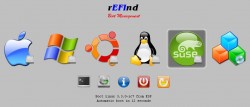Dual booting MacOS and Windows is super easy with BootCamp, but what about Linux? The answer is disappointing, with BootCamp you are not able to install Linux. Today I want to help you get a Linux distro running on your Mac.
In this guide, you are going to need to leave BootCamp for a bit more of a hardcore boot manager called rEFInd. rEFInd will allow you to boot into any operating system of your choice; MacOS, Windows or Linux. Before we install rEFInd we are going to need to make sure that you don’t have full disk encryption (FileVualt) enabled on your Mac. If you do please disable it first.
That said, let’s begin.
Step 1 : Get rEFInd
- Visit the rEFInd page on SourceForge (Open Source!!! :) )and click the Download button to download the latest refind-bin-[version].zip file.

- Open a Terminal window by pressing Command + Space and, typing Terminal, and pressing Enter.
- Drag and drop the install.sh file from the downloaded zip file into the terminal window and press Enter to run it.
- Once installed, you will need to full shut-down and power on your Mac. Do not reboot it, there is a difference.
Step 2: Partition Your Mac
 It’s time to make room for your new Linux installation. You are going to do this in the Disk Utility, to open it;
It’s time to make room for your new Linux installation. You are going to do this in the Disk Utility, to open it;
- Press Command + Space
- Type: Disk Utility
- Press Enter
Now select and resize your hard-drive. I recommend 40GBs so you have room to grow, but all you really need is 10GBs for a basic install. Once you resize make sure not to partition the empty space, Linux will format it for you.
Step 3: Install Linux
You are going to need a Linux installation media to continue. For example, if you’re using Ubuntu, you’ll need to download an Ubuntu ISO file — download the “64-bit Mac” version. Burn the ISO to disc or follow Ubuntu’s official instructions to create a bootable USB drive from the ISO file.
Now you will need to reboot and select the USB or ROM drive with the Linux disc and boot into it.
Start your Linux installer and go through the installation process. On Ubuntu, launch the Install Ubuntu application from the desktop and install Ubuntu as you normally would. Be sure to select the “Install Ubuntu alongside Mac OS X” option instead of overwriting your Mac OS X system with Ubuntu. The installation process should otherwise be normal.
 Step 4: Done
Step 4: Done
Now that your Linux installer has completed, you will need to select which operating system you boot into each time the computer starts up. There you have it, Linux on your Mac.

 Email article
Email article



